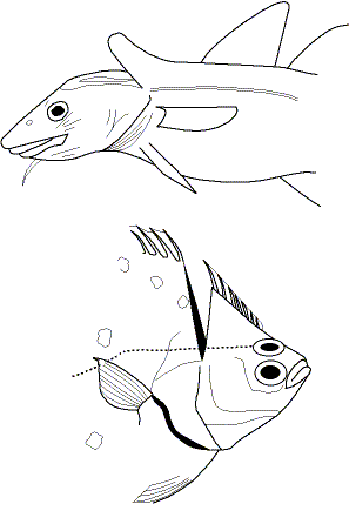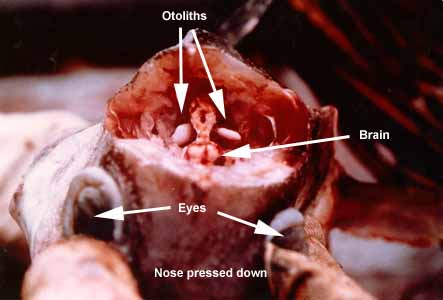Removing Otoliths
Otoliths of adult fish can generally be removed with nothing more than a sharp fish knife and a pair of forceps or tweezers. With a little practice, the large pair of otoliths (the sagittae) can be removed in 15 seconds. Marine fish such as cod and haddock have otoliths which are relatively large and therefore easy to find (about 1 cm long in a 30 cm long fish). Smaller fish, such as minnows, may require the use of a microscope.
There are many ways to remove a pair of otoliths. Here is one way:
1) Use a knife with at least a 15-20 cm blade. It should be as sharp as possible. You'll also need a pair of forceps or tweezers about 10 cm long.
2) Grip the head of the fish by putting your thumb and forefinger in its eye sockets (it IS dead remember!). Lay the body of the fish on a counter with the tail pointing away from you.
3) Put the knife blade on the top of the fish's head about 1 eye diameter behind the eyes. Slant the blade AWAY from you, at about a 30° angle.
4) Slice back and down about one head length. You should feel the knife cut through the top of the skull. For flatfish and some other species, a vertical cut through the top of the skull directly over the preopercle (the curved line 3/4 of the way back on the gill flap) also works well.
5) Check to see if you've cut the top off the skull. If you haven't, make another slightly deeper cut. An ideal cut removes the top of the skull, revealing the full length of the soft white brain underneath. Note that the brain joins the much narrower (but still white) spinal cord at the rear. Once the brain is visible, expose the brain even more by pressing the nose and body down and towards each other. This should "snap" a portion of the skull, and push the brain and otoliths up. Very often, this exposes the otoliths and allows them to be removed immediately.
6) Push the rear of the brain to one side, or cut it out all together. The large pair of otoliths should be visible underneath the rear of the brain, still inside the skull. They may or may not be resting inside hollows in the base of the skull.
7) Use forceps to pull out both otoliths. They will not be attached to anything other than soft tissue. Clean off the otoliths with water or your fingers and store dry in a paper envelope until you're ready to age them.
8) Try another one! You might be surprised how much faster this one goes!
The above approach works well for most fish species. However, other approaches work better for some fishes. For a more detailed list of alternatives, see the on-line manual "Otolith Removal and Preparation for Microstructural Examination".

